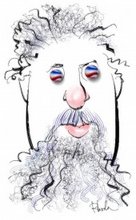The basic idea is this... I am =andy, you are =steve, I can create any number of directed, typed, relationships to you by using the extensibility of the =andy namespace....
=andy*(=steve) establishes a generic relationship.
=andy*(+friend)*(=steve) establishes a friend relationship.
=andy*(+trusted)*(=steve) establishes an actionable relationship.
Let me point out the thing that I think are cool about this...
- These entries MUST have been added and/or removed by the entity that controls the =andy name space.
- Typed relationships can take advantage of the 'dictionary' space (xris that start with '+') and therefore solve a lot of the semantic mapping issues.
- By creating this entry in my name space this relationship has its own i-number, I have very literally reified the relationship. The relationship can have metadata, services and any other quality of a top level entity.
- The target of the relationship can USE this identity; =Steve can assert =andy*(+trusted)*(=steve) as their identity... the fact that xri resolution for this succeeds 'prooves' that =andy established the relationship... You can xri resolve =steve for whatever flavor of authN service that you are interested in so the 'user' can 'proove' they are =steve... I AM =steve who has a (+trusted) relationship with =andy.
- Group management IS relationship management =andy*(+family)*(=richard).
- Relationships are STRONGLY directed. An assertion about a relationship with =steve means only as much as you decide to put on it. Did you know that me and Bill Gates are best buddies and that I'm married to Angelina Jolie?
- It is ALL public. Maybe once I have finished reading the ID-WSF Service Discovery Spec I'll have a better idea how to mix and match the public and private parts of this in a more privacy protecting way.
- There is no native xri way to query the graph. Even if I wanted it to be public there's no (currently speced) way to get all of =andy's +trusted people.
- When I sign up for the genealogical service it is understood that write rights are granted to =andy and =andy*(+family)*($children) and read rights are given to =andy*(+family)*($descendants)
- I can send a message to =andy*(+trusted)*($all)
We must not get confused between the world and the map of the world. It's great that with todays technology we can create these interactive maps that let you:
- show all the houses and the roads
- now turn off the roads and show the electric grid
- now only show the sewer lines

1 comment:
You are right about "the map vs the world". But the thing is that you can get only the map while talking about the computers. Similar as you cannot get the real house inside your laptop :-)
See this paper for more details:
http://storm.alert.sk/work/papers/files/semancik-basic-properties-of-persona-model.pdf
Post a Comment